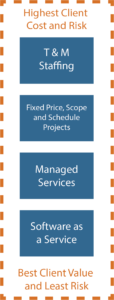I thought Per Werngren made some important observations in his recent article for Redmond Channel Partner Magazine. His main point: System Integrators (SIs) need to evolve their business models or risk disintermediation. As workloads are migrated to AWS and Azure, automation replaces the need for people to perform those tasks. This automation enables governance and compliance to standards, while also setting the stage for better downstream, fully-automated management, monitoring and operations. This, of course, further reduces the need for people performing in those roles,
Meanwhile, the new generation of intelligent PaaS services for predictive analytics, artificial intelligence, machine learning, etc. are also replacing jobs once done by hand. These new tools allow us to build better and more intelligent applications.
FREE HALF DAY SESSION: APP MODERNIZATION APPROACHES & BEST PRACTICES
Transform your business into a modern enterprise that engages customers, supports innovation, and has a competitive advantage, all while cutting costs with cloud-based app modernization.
Despite all this potential for automation, we still regularly see organizations allowing contractors to move workloads manually. It’s simply in a staffing contractor’s best interest to have people do this, despite it being a time-consuming and error-prone process. But why would an SI recommend automation and reduce their long-term revenue?
At AIS, our approach is to do exactly the opposite of that, and we opt for automated processes whenever possible. We want to get things done more quickly and at a lower cost so our clients can spend their money on accomplishing more from a business perspective. Our clients consistently appreciate our insights and this approach leads to us becoming a trusted adviser, rather than your typical contracting firm.
 Staffing is at the bottom of the technical services value chain. All the cost (and the risk!) is pushed onto the client. One step above that is to deliver solutions as a turnkey project, with fixed schedules and budgets. Next comes managed services where the services provider defines a service level agreement (SLA) and associated fees. (This normally includes monthly fees with premium charges when the SLA is exceeded.) Finally, delivering Software as a Services (SaaS) provides the client with the most value and least risk as the services firm provides a turnkey solution which the client pays for monthly, usually with a multiple year contract so the provider can realize the return on their upfront investment to fully deliver the solution.
Staffing is at the bottom of the technical services value chain. All the cost (and the risk!) is pushed onto the client. One step above that is to deliver solutions as a turnkey project, with fixed schedules and budgets. Next comes managed services where the services provider defines a service level agreement (SLA) and associated fees. (This normally includes monthly fees with premium charges when the SLA is exceeded.) Finally, delivering Software as a Services (SaaS) provides the client with the most value and least risk as the services firm provides a turnkey solution which the client pays for monthly, usually with a multiple year contract so the provider can realize the return on their upfront investment to fully deliver the solution.
We are a mid-sized company, but we compete with the largest SIs in the United States for business with some of the largest enterprise organizations. Once a large SI is entrenched in an account, they usually seek to keep the status quo. They are compensated to grow revenue. So they want to keep what they have and grow that. We have fought for years to get clients to see the value in public cloud infrastructure, and we are often fighting against entrenched SIs that don’t want to change their staff or have to incur re-training costs. I am happy to say we have won our fair share of these battles, and the amazing investments Microsoft has made in Azure certainly enables that success.
AIS has led numerous Azure migration automation projects by pioneering a Service Catalog approach to DevOps, along with the creation of the Azure Blueprint to enable governance and automate compliance to commercial and federal standards. See the following related AIS blogs:
- The Pentagon Wants to Head to the Cloud. AIS Can Lead the Way
- Ignite 2017: ARM & Compliance
- Secure DevOps with Azure Blueprints
- Cloud #DevOps: Bridging the “Expectations Chasm”
- Enterprise #DevOps: A Service Catalog Driven Approach – Part 1
There are many very large procurements on the way as large commercial and public sector organizations seek to migrate to public cloud infrastructure. We encourage the contracting teams to seek solutions that automate as much as possible and then seek to manage the solution as a service.
Unfortunately, many of the contracting shops only have the ability to compete contracts for staffing in a lowest price, technically acceptable (LPTA) approach. But embracing public cloud infrastructure is a highly complicated journey both in terms of technology and organizational approach. It’s simply not possible to commoditize this work with only low-cost staffing. Through the process of helping dozens of large enterprise organizations on their cloud journeys, we take what we learned and used it to define our Cloud Adoption Framework as a guide for our clients to follow.
(We recently evolved this framework specifically to the unique needs and regulations of the DoD, which you can read about here and here.)






